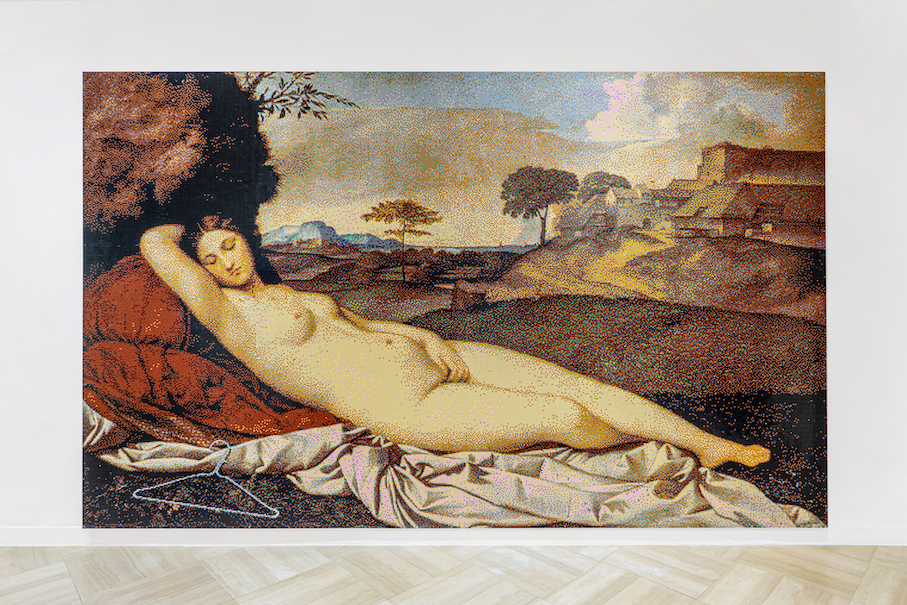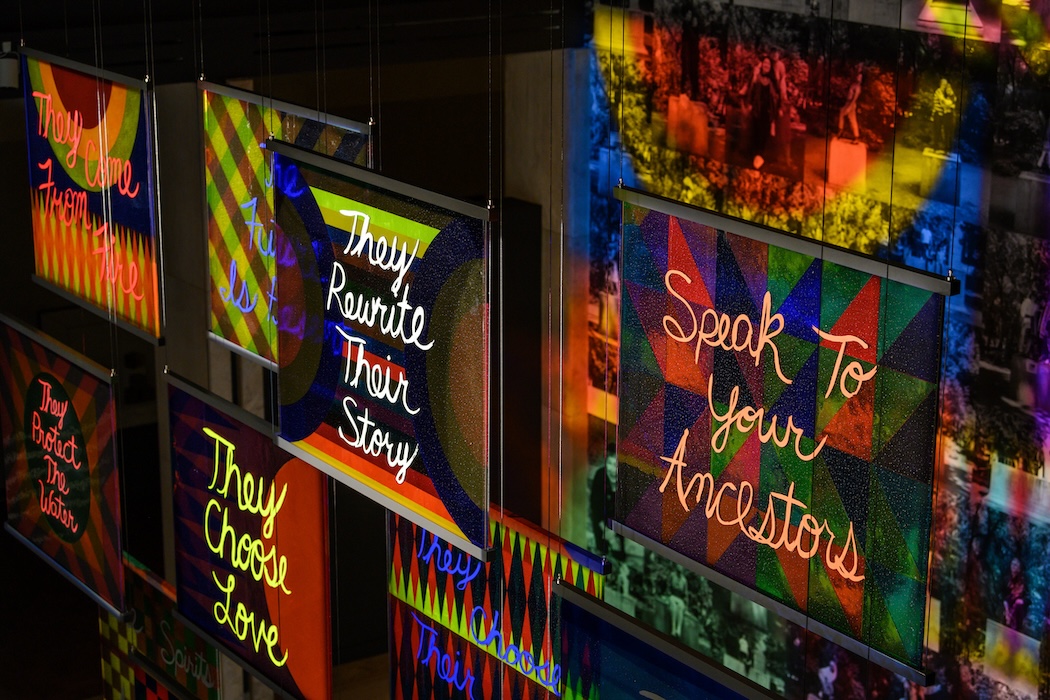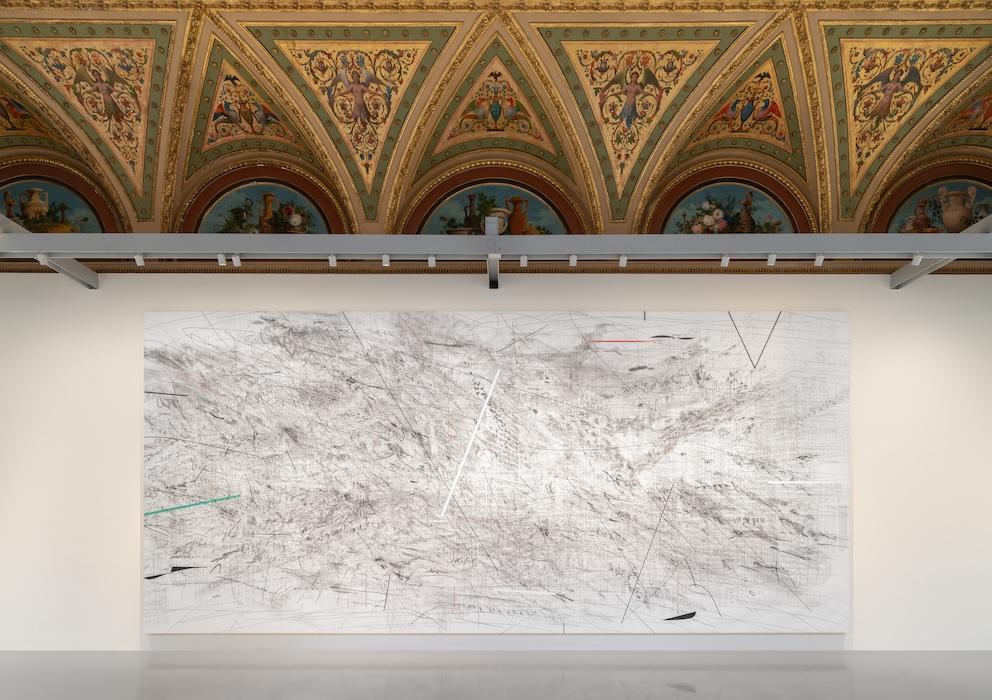“All the World’s Futures,” curated by Okwui Enwezor, takes on the injustices of the past and the crises of the present. Through his exhibition in the Arsenale and the Central Pavilion in the Giardini, Enwezor seems to be wagging his finger at governments and their policies for the dismal conditions in the world today. At a press conference in Paris in March, Enwezor said, “We know that evoking the dramatic facts and occurrences that characterize the present also means admitting history.” This highly political show carries the sentiment that the amalgamation of artworks made by 136 artists have been largely chosen to illustrate Enwezor’s bleak outlook.
Enwezor sets his tone at the entrances of both sites. In the Arsenale, visitors are greeted by Adel Abdessemed‘s Nympheas (2013), clusters of knives jammed into the ground, and Bruce Nauman‘s neons – one from 1983 displays opposing notions such as death/love, knows/doesn’t know, cares/doesn’t care. It’s as if we’re being reminded of the world’s apathy at the sight of a battlefield. This leads us on to Melvin Edwards‘ ongoing Lynch Fragments (started in 1963 about racial violence in the US) – wall sculptures made from hammers, batons, horseshoes and iron spirals, and Monica Bonvicini’s Latent Combustion (2015), suspended chain saws covered in black rubber. Violence is expressed, too, in Pino Pascali‘s Cannone Semovente (Gun), 1965, from the Arte Povera artist’s Weapons series and in Hiwa K‘s The Bell (2015), a church-like bell which the Iraqi-Kurdistan artist made by melting down war waste on Iraqi soil. Then there are Nidhal Chamekh‘s series of drawings about the Arab Spring, De quoi rêvent les martyrs? (2012, What Do Martyrs Dream About), depicting body parts, battered faces, guns, and police batons. At times, it all feels like an unremitting scream against the never-ending war machine.
The injustices of the world are also conveyed in Keith Calhoun and Chandra McCormick‘s black-and-white 1980s photography of imprisoned black men digging ditches at Louisiana State Penitentiary in the US. And in Steve McQueen‘s Ashes (2014-2015) about a young Grenadian fisherman who was killed after finding a drug’s haul on the beach. On one screen he appears as a young, carefree guy on a boat, the second screen shows his friends making his gravestone. Further along is French artist Lili Reynaud Dewar‘s moving installation My Epidemic (Small Bad Blood Opera), 2015, comprising softly colored banners with poetry alluding to AIDS, a video featuring the artist, and music.
The headiness of all this gets broken up by pieces like Katharina Grosse‘s sprawling installation of walls, boxes, and textiles painted in a riot of color; the lushness of Chris Ofili‘s new tropical paintings; the formal domestic settings by Thea Djordjadze; and Tiffany Chung‘s Syria Project (started in 2011) of intricate, delicate drawings – each drawing relating to a mapping of the numbers of casualties and refugees on a specific day. The Arsenale ends, bizarrely, with new upside-down self-portraits by Georg Baselitz portraying himself as a frail, old man. Is this Enwezor’s way of admitting defeat in the face of the world’s turmoil?
In the gardens, a touch of dreamy repose is enjoyed in Sarah Sze‘s elliptical installation that merges with the natural surroundings–a blue hammock floats in the breeze, lines are painted onto rocks, and threads dangle from trees.
At the Central Pavilion, the serious mood starts before one even steps inside. Oscar Murillo‘s heavy, black canvas flags (signaling devices in now bastard territory, 2015) hang on the facade as if they’re ready to be torn down and used for makeshift tarpaulin shelters. Above them, Glenn Ligon‘s neon blues blood bruises overwrites the name of the pavilion, La Biennale, as if it’s suggestive of all the pain and turmoil in the event’s history.
The idea of suffering continues with Fabio Mauri‘s Il Muro Occidentale o del Pianto (The Western Wall or the Wailing Wall), 1993 – a four-high-meter wall constructed of suitcase. While the title refers to Jerusalem, the piece alludes to the luggage of those deported to Auschwitz. As in the Arsenale, Enwezor mingles well-known names with those on the art world periphery. Count in new skull paintings by Marlene Dumas and Isa Genzken‘s orchid and white architectural sculptures besides works by Robert Smithson, Christian Boltanski and Andreas Gursky. Less on the radar, however, is Emily Kame Kngwarreye, an Australian artist from the Aboriginal Anmatyerr people, whose Earth’s Creation (1994) comprises four vast panels depicting desert landscapes after a rain pour.
As in the Arsenale, the subject of living conditions and poverty is evident, such as Walker Evans‘ documentary images taken during the economic depression of 1930s America. A lighter critique on today’s labor market is Jeremy Deller‘s blue banner with white writing reading Hello, today you have day off. [sic] (2013), referring to a message sent to an employee in Britain on a zero hours contract.
The focal point of the pavilion is Isaac Julien directing the live reading of the three volumes of Karl Marx’s Das Kapital in the arena designed by David Adjaye. However, watching a few passages being read aloud has little meaning. It only serves to underline Enwezor’s critique of global financial systems in a biennale that feels like a political manifesto expressed through art.
“All the World’s Futures,” the 56 edition of the Venice Art Biennale, runs through November, 22 2015.








